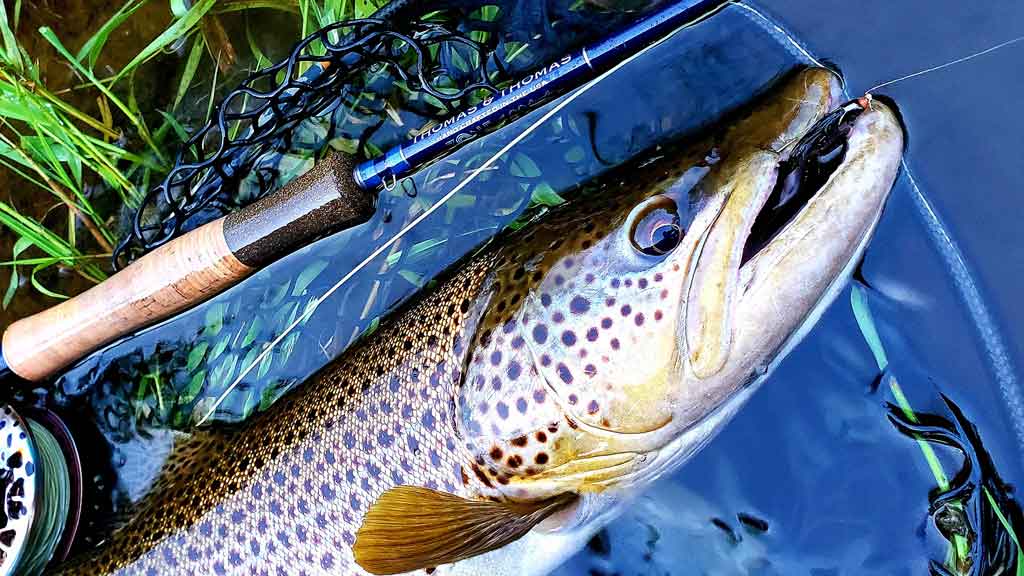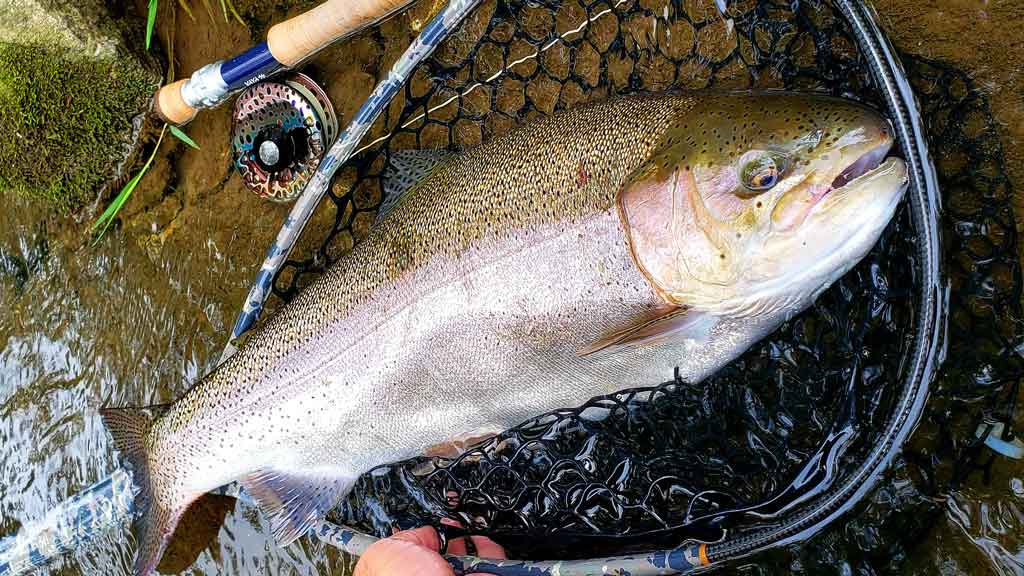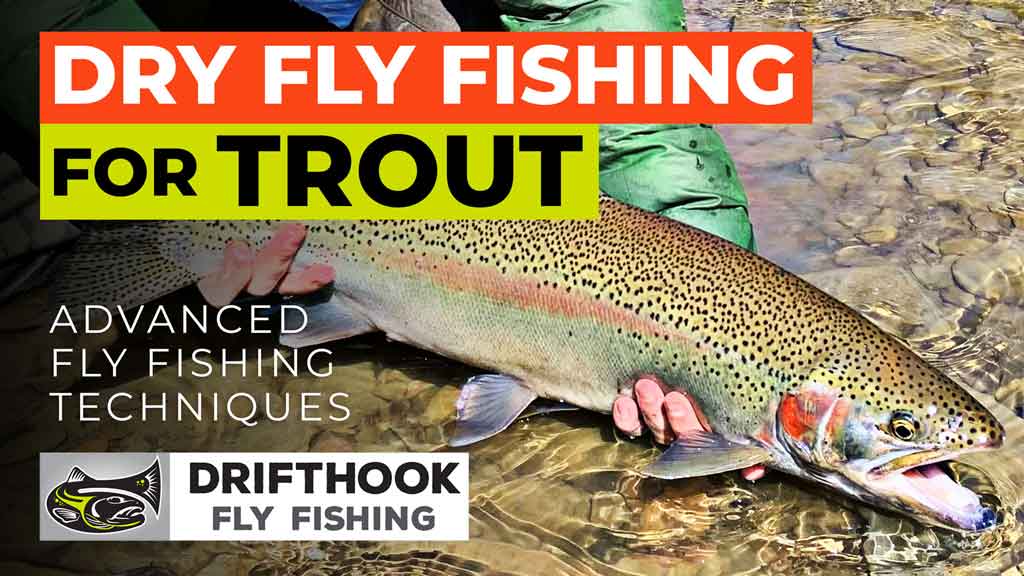Let's understand first what exactly fly fishing is about. It's not just about enjoying time among nature and wildlife. It's not just about catching the biggest fish. It's about trying to outwit the fish, be cunning, be more intelligent than the fish you're trying to catch.
Not to mention, you will also learn how the river or stream ebbs and flows. Being more in touch with nature can also be relaxing and great for your mental health. But what type of fly fishing is the best?
As a general rule, fly fishing can be broken into two three categories for success:
- Nymphing - Is great for quantity and size.
- Dry Fly Fishing - Is great for excitement and technical presentation.
- Streamer Fly Fishing - Is excellent for catching large trout.

In this regard, fly fishing is the ultimate battle of wits between man and fish. Fly fishing refers to exactly what it says in the name. It's an attempt to mimic food sources such as mayflies, caddis, midges, stoneflies, other fish and aquatic invertebrates such as leaches and worms .
The various flies can imitate the birth cycle of the fly or insect. Trout and other fish prey on these insects as they are born, swim around, try to make it to the surface, rest awhile on the surface before flying away. Our job as fishermen is to try and mimic the movement and behavior of these food sources, to trick a trout into taking a bite.
What is Nymphing?
Nymphing is very popular because it imitates the fly in its most vulnerable stage, causing fish to pay more attention to it. Nymphs are the immature form of a flies lifecycle. They are meant to be fished underwater.
Some come weighted meaning they will sink below the surface and hang just off the bed of the river or lake. As pertaining to the name, the nymph will represent the insect in its nymphal stage to the fish, and because they are so weak and vulnerable, they will typically float downstream.
Fish will hunt these nymphs as they are weaker, pose an easier meal, and they are more predictable as they generally can't always make it upstream. Young and mature fish will feed on nymphs, so you have a variety of fish, and thus, a higher number of fish will take a shot at your fly.
Pros and Cons of Nymphing
Pros
- You will catch the most amount of fish nymphing.
- Nymphs are about 90% of a trout’s diet as most of them will feed subsurface.
- If you fish with an indicator, it's very beginner-friendly and makes the learning curve a lot less taxing.
- Since nymphs represent an early stage of a fly, they don’t require a lot of detail and complex structure. Hence they are usually the cheapest type of fly you can buy.
- Reading a moving body of water can be challenging but as soon as you know the feeding zones of trout your chances for success increase.
Cons
- You will catch the most fish, but you might have more enjoyment testing you're casting and visual skills dry fly fishing.
- Nymphing can sometimes present a smaller fishing window, as fish will feed, mature, and become larger, going for more giant juicier flies trying to swim and reach the surface.
- Nymphs are cheap, but you may tend to lose them more often because they are small and vulnerable. So be ready to spend a little to buy new nymphs, usually every time you go fishing or buy in bulk.
- The lighter tippet used for the smaller flies can withstand 3-5lbs of pressure before they snap, so be prepared to carry tippet with you to change out flies.

What is Dry Fly Fishing?
Dry fly fishing imitates a mature adult insect, trying to rest on the surface before flying away. Dry fly fishing is almost the opposite of nymphing. The dry fly is not as heavy as the nymph, and thus, it can be used to fish on the waters surface. It's a good idea to look for riffles in the water.
These are shallower sections of water, with generally fast-moving flows, which is excellent for several reasons. Not only can the trout see the dry fly better thanks to the shallower water, but you are more likely to get larger, stronger trout to go after your fly.
You're also not going to be blind casting, hoping that you fly lands in front or overhead of a fish. You are usually going to be walking upstream, targeting individual fish after you have visually identified them.
As you can imagine then, you will be closer to the fish, and your presence can spook the trout. So, making the correct cast makes the proper presentation make dry fly fishing a lot more skillful and exciting.
Pros and Cons of Dry Fly Fishing
Pros
- It's tremendous fun! You're up against larger, more intelligent fish, and that presents a challenge worth getting hyped up over.
- The equipment is relatively the same as nymphing. The lines will hold 3-5lbs of pressure. The rods are just slightly thicker and heavier, but not by much.
- The rods can be shorter as well, as you are casting upstream and wading through the water or fishing closer to your catch.
- Stalking is a brilliant way to catch fish. It forces you to learn how the river is shaped and flows.
- The flies can be more sophisticated than nymphing as they must float on the surface. It makes for a more fun lineup of flies you will take on your trip.
Cons
- Dry fly fishing takes more skill than nymphing. Not only do you have to learn about river mechanics, but you have to be aware that the fish you’re trying to catch is a lot smarter than a youngster who dares not go up to the surface.
- The learning curve is a little steeper and perhaps not suitable for beginners.
- Since you are targeting individual fish, you have to cast into their feeding lane, so it requires a more accurate cast and control of the rod. Not to mention, you must constantly mending the line as your fly travels downstream towards you.
- Usually, you will need to approach the feeding feeding lanes from an angle, about 45-degrees most times. This is because you don't want the fish to see you or your line hooked to the fly. It takes knowledge, patience, and proper casting.

What is Streamer Fishing?
Streamer fishing is the big league of trout fishing. This is not for the easily frustrated or those with a lack of patience. It takes time to learn how to do the proper casts, how to swing through properly, when to release your line, etc. However, you are going to be catching the largest, meanest, most beautiful trout you can. Much like nymphs or wet flies, you'll be using slightly weighted flies.
The flies will imitate a large meals that are available in the water, or perhaps an insect that swims under the surface like a leech, or some other protein-packed meal for the fish. Streamer fishing will imitate larger bait, such as crayfish, baitfish, ordinary aquatic life, and sometimes dragonflies or larger flying insects.
Therefore, streamer fishing is for those that want to catch big fish with an intense fight in them. Depending on how big of fish you are going after, you might need a heavier rod with a weight line to plunge the fly deeper and faster into the water.
Pros and Cons of Streamer Fly Fishing
Pros
- You can cast across the stream or river. This means that you can stay out of the water if you want, cast over the top of the trout, which means your line is usually hidden from their sight.
- You will be catching the biggest fish! Isn't that the most exciting thing about fishing, catching the monsters in the water.
- You can cast in obstructions such as beaver dams, near foliage coming out of the water, and opposite banks. You want the fly to sink into the middle of the deep water and close to the banks so that the trout can come out of their hiding place.
- The line is stronger, 4-6lbs of pressure.
- The flies can be incredibly creative and fun to make at home. They are supposed to look like mature insects, fish, and aquatic creatures like leeches or worms.
Cons
- The learning curve is far steeper than the other two types we have discussed.
- You have to learn or work on your strip set method. Don't just lift the rod up trying to hook a fish. Lift it and strip your line back towards your waist at the same time. Rather than a standard hook set or trout lift, it kind of snatches the hook into the trout's mouth quicker and with a little more force.
- You need to learn how to imitate baitfish and other aquatic life with your retrieves. Be more patient. Retrieve the line 6-inches at a time, with a 1-2-second pause. It takes a little imagination and a lot of work for each cast you make.
- You do have to be very patient at times. Remember, you are fishing larger mature trout which have gotten to that size because they have been smart enough to avoid becoming prey themselves. It's an actual battle of wits.
Where and When to Go Fly Fishing?
As you can tell, each type of fly fishing is done in slightly different environments. They have more similarities than differences. However, if you can understand the differences, you'll have more success with each.
Nymphing
Rivers and streams are ideal location to do a bit of nymphing. Bear in mind you will be going after trout that are feeding on the bottom or going for emerging insects. Immature insects don't move quickly, and they don't have the power to get to the surface. So the younger trout can get easy meals hunting these little fledglings.
Dry Fly Fishing
Dry fly fishing is best done in rivers and streams that don't have a fast pace but have a decent flow rate. The stronger trout will be hanging back near breaks in the water to catch the stronger adult flies emerging up to the surface of floating on it. Look for obstructions in the river, such as rocks, or natural eddies. This inherently means you will be fishing in fast streams that have been slowed a little.
Streamer Fly Fishing
Streamer fishing is pretty simple in terms of location selection. You can streamer fish anywhere. You can fish in lakes and other still waters, freestones, and tailwaters and fish when other conditions don't allow it, such as slightly darker or high water. Part of this mature fishing type is to learn how to spot a bite on the line, cast accurately, mimic a bait, and spot the signs of the water on the surface moving as fish are drawn nearer to the fly.
For more information on our top 25 places to go fly fishing check out our full article here >
So, which type of fly fishing is best for you?
What flying is the best? The answer is, it depends on what you want to catch and do. If you're a beginner, nymphing is by far the best option. The equipment is the most affordable, you can be creative with your flies, and you can learn the basics in a non-stressful environment. Not that fishing is any stress anyway!
If you use an indicator, you'll be able to spot the movement of the fly much better. You'll also learn how to host the fly just above the bed and underneath the surface. The learning curve isn't as hard as you think it might be.

If you want to challenge yourself you should try dry fly fishing. The fly will float on top of the surface, imitating an insect that has fallen off the trees or perhaps a youngster about to fly away. This means you'll be after more confident and thus larger trout. You have to keep your eye on the fly all the time, so when it does get pulled beneath the surface, you can go real in the line.
Streamer fishing is for the seasoned fishermen. You will need better equipment, a solid mindset, patience, and a fantastic casting technique. It's best to learn how to cast in your back garden for stream fishing. Because the fly will sink quickly, it won't move a lot.

The still water won't move your fly much either, so you need to learn how to imitate a fish, aquatic creature, or insect. How you retrieve the line helps to do this. You can also wiggle the rod a little to move the line around and fly. If you want to catch mature trout but have less frequent catches, streamer fishing is for you.
Flying fishing is incredibly great fun. There is no actual 'best' type. They all use different types of flies, different rods, different lines, and different locations. They are progressively difficult, so beginners should go for nymphing, advanced should go for dry fly, and the most experienced should try streamer fishing.
If you would like to know more about fly fishing and how you could get involved in this great hobby/sport, you should feel free to contact us today. Ask us any questions you might have, and we'll happily point you in the right direction. You can call us on 1-773-FLY-FISH or email us at info@drifthook.com.

About the Author
Matthew Bernhardt, a third-generation Coloradan, grew up at the forefront of the state’s fly-fishing revolution, enjoying time on the water, side by side with experienced guides and lifelong anglers.
By combining his passion for fly-fishing with input from other experienced fly-fishers and guides and his fine arts degree from Colorado State University, Matthew spent five years carefully developing the Drifthook Fly Fishing System, built to help every angler catch more trout.
When he’s not spending time with his wonderful family, you’ll find him out on the water catching MONSTER trout, and he anxiously looks forward to the day when his kids are old enough to join him there.





1 comment
Catch/release
I’ve done it all and for years. I see several guys nymphing with their indicators and struggle to catch fish. I tight line with no indy. Many ask what are you catching them on. My reply " it’s not the fly it’s the presentation " Presentation always wins in our sport. Started my boy at 7yr old FF. He’s a legend around here and show men up every time he hits the water. He’s 15 now and does it all. I fell asleep newbie should start with wets/streamers after they learn how to roll cast and control their line. Only have to watch 2 minutes to know if a guy is or isn’t.
I’ve done it all and for years. I see several guys nymphing with their indicators and struggle to catch fish. I tight line with no indy. Many ask what are you catching them on. My reply " it’s not the fly it’s the presentation " Presentation always wins in our sport. Started my boy at 7yr old FF. He’s a legend around here and show men up every time he hits the water. He’s 15 now and does it all. I fell asleep newbie should start with wets/streamers after they learn how to roll cast and control their line. Only have to watch 2 minutes to know if a guy is or isn’t.